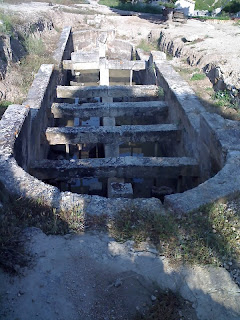

Although we were staying in Ancient Corinth, we did not intend to visit the site as we had seen it before. Our target was actually Acrocorinth set high on a hill to the south and we had intended to visit it yesterday but decided to wait until it stopped raining! And that was the problem again this morning with more heavy rain in the early hours and low cloud made Acrocorinth look very unappealing!
We implemented Plan B, which was to cross the Corinth Canal and visit a site on a peninsula that sticks out into the Gulf of Corinth that separates the Peloponnese from Northern Greece. On the way we passed through the bustling, cosmopolitan town of Loutraki famous for two things – its water and its casino. Loutraki means baths or hot springs and this is one of the most visited spa resorts in Greece. It is built on the site of ancient Therma (hot springs) and has saline waters at 30°C that are used internally and externally to treat dyspepsia, arthritis and liver complaints. Loutraki is also the source of Greece's most popular bottled water but this must either be from a slightly different source or they must remove the salt first.
We didn't stop in Loutraki but drove on to Lake Vouliagmeni, once a land-locked lake until 1880 when a channel was cut through the narrow strip of land that separated it from the sea. This is a very pretty spot with pleasant-looking tavernas and some wild camping possibilities at the northern end, just off the road.
We drove on to the tip of the peninsula where we found the lighthouse that we had seen looking across the sea from the Aphrodite Waters Camperstop. Here we parked in the large car park and headed towards the lighthouse and the hill that looked down onto the archaeological site of Heraion. There were small signs of an ancient settlement on the lighthouse promontory but from the hill looking down to the harbour and the hill behind we had an excellent overview of the major buildings. The Heraion was a site sacred to the goddess Hera and three temples have been found dating to the 9th, 7th and 5th centuries BC. The earliest temple is thought to have been a mud-brick structure with a thatched roof. It is a very compact site and there is very little information available but its position by the sea with views across to Corinth, the mainland to the north and down the Gulf of Corinth make it rather special. One intriguing building is a dining room where diners feasted as part of the rituals associated with the Hera cult. The benches on which the diners reclined can still be seen. We were lucky with the weather here as we had sun and no rain whereas we looked across the Gulf to see Corinth and Acrocorinth under cloud and more rain.
We wanted to spend some more time looking at the views so we decided to wild camp there. I went in search of a round structure east of the site mentioned in the Blue Guide but failed to find it in amongst the trees and scrub but it was a pleasant ramble.
It was noticeable how popular a spot this is with the locals who came out for picnic lunches, afternoon strolls and to watch the sunset.
As we sat in the van, a sudden thought came to me – our rarely used, old, second mobile phone has a camera. I had always dismissed it as it is very low resolution and certainly no match for either of our cameras but it could be a life-saver. I tried it out and it is poor quality but for posting on the blog it might just do. I will let you be the judges.
Photos: Heraion – view down to the lower site; Heraion – the 5th century BC cistern.
No comments:
Post a Comment